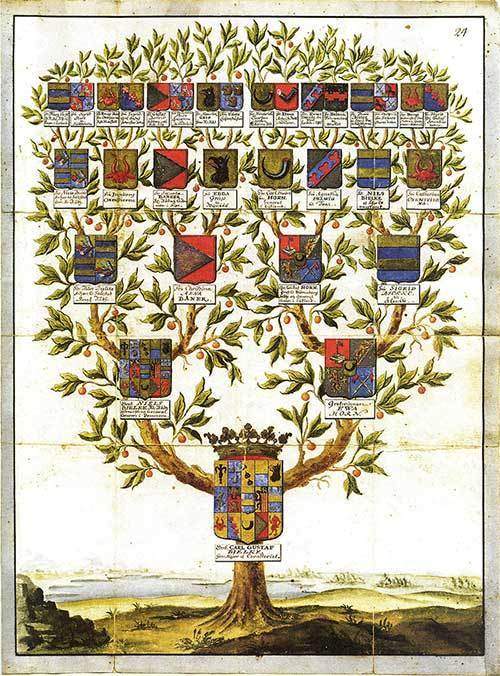Genealogy and family trees, why they are important

- 1976
- 34
- Austin Stokes
Genealogy It is one of the auxiliary sciences of history which allows to trace the origins of a person, family or community from determining who their ancestors were and where they came from. But it is also very useful for health sciences.
According to the Dictionary of the Royal Spanish Academy, the word comes from the Greek Genos: race, birth or origin, and Logos: science, study or knowledge. Genealogy would then be the discipline that studies the parents and ascendants of a person, as well as the origin and evolution of something.
The British encyclopeedia, For its part, define it as "The study of the origins and history of the family. Genealogists compile ancestors lists, which organize in family trees (pedigree chair). The forms vary from the rudimentary to the comparatively complex ones; Genealogy can be found in all nations and periods".
Content
Toggle- What is genealogical research
- Genealogy History
- The study of genealogy and family trees
- What can our family tree help us to know?
- References
What is genealogical research
Genealogy research work consists of Collect the greatest amount of background through oral and documentary sources. The first source used is the memories the person and close relatives. The second are the documents collected in civil records, historical archives, churches and hospitals. Eventually archaeological sources and the study of artistic representations are used. Lately, the Digital files and genetic tests.
Genealogy History
Genealogy was already used in ancient times. In his poem Theogony, The Greek poet Hesiod (6th century AC) performs a genealogy of the legendary gods and heroes. Virgil's famous work (70 - 19 AC), Aeneid, Written on the commission of the first Roman emperor Augusto Cesar (63 AC-14 DC), explains the mythical origin of Rome from the Trojan Aeneas, making a genealogy that reaches the emperor himself (which attributes to be a descendant of Aeneas and Romulus). In the Bible We find numerous genealogies that begin with Adam and Eve, and date back to Jesus Christ. In the seventeenth century, Archbishop James Usher (1581-1656) of Ireland used this genealogy to calculate that- according to the Scriptures- the Earth should have been created on Saturday, October 22, 4004 AC at 6:00 p.m.
In ancient China, respect for ancestors and older also led to registering the origins of each person. In Islamic countries it served to identify the descendants of the prophet Mohammad (Muhammad) who claimed the caliphate, so the genealogy had great political and religious importance. In countries like India, where polygamy, concubinage and adoption was common, helped avoid problems with inheritance and property. In Ethiopia, genealogies were built to justify the belief that the emperor was a descendant of the Hebrew King Solomon and the African queen Saba.
In the Medieval Europe people belonging to the nobility and royalty were interested in investigating their family origin And they performed genealogical trees, not only to prove their "blue blood”, But also to determine the succession in public office. An example of this was the death in 1286 of the King of Scotland Alexander III and the subsequent death of his only surviving descendant Margaret of Norway in 1290, who led to resort to genealogy to find the closest relative in a position to inherit the crown. More than a dozen European kings were awarded the Scottish throne, which led to the English invasion of the territory.

In the Mediterranean coast families used to transmit their genealogy orally through stories and poems where fiction was mixed with reality.
From Trento council (1545-1563) Catholic Church decided to register all the rituals that occurred in the parishes. This generated a lot of documentation that forced its order, classification and care. Therefore in the European and American parishes you can find books with minutes of baptisms, confirmations, first communions, marriages and deaths that dating from the 16th century. The structure of a baptism act was as follows: name of the parish and that of the town or city, the day, month and year, name of the minister of the sacrament with his title, the name and personal data of the baptized, the time, day and place of birth with the name of parents, neighborhood and nature; Also the name, surname, address and nature of both the paternal and maternal grandparents and ending with the name and surname of the godparents. The other documents keep a similar structure. With modifications, this system remains to this day.
From modernity, with the rise of the bourgeoisie and the appearance of capitalist forms of production the preparation of family trees ceased to be something of the aristocracy to begin to interest society.
In 1928 the First International Congress of Heraldry and Genealogy was held in Barcelona, which was of great importance to establish universal forms of genealogical tree construction, the promotion of genealogy and the training of professionals in the area. This congress influenced the creation of genealogical societies worldwide. An example of this was the Creation in 1940 of the Argentine Institute of Genealogical Sciences, that the following year began editing his magazine. This institution carried out the genealogy of several illustrious families in the country, tracking its origins until the time of the Spanish conquest.
The study of genealogy and family trees
One of the most ambitious genealogical projects is undertaken by the Church of Jesus Christ of the last days. Popularly known as Mormons, The members of this Church founded in 1894 the genealogical society of Utah in Salt Lake City, with the aim of creating "a macro database that brings together the family history of all humanity". In 1938 they undertook a project for microfilmar documents from parochial and municipal archives. The conservation is strict, so much that the microfilmed information is guarded in its gigantic database located 200 meters underground, in the battleship of the Utah granite mountain, 40 kilometers from Salt Lake City. It is estimated that there are currently 2.4 million rolls and 1.5 million photographs from 100 countries and in more than 170 languages. In addition, these documents are digitized and put at the service of users through a web page.
However, The largest genealogical tree made until today is the one made by a team of American and Israeli scientists under the direction of the researcher Joanna Kaplans of the New York Genome Center. In total, personal data of 86 million people and 13 million records were examined, to prepare a tree of 110 million people that allows to trace the ancestors of each up to 11 generations and 500 years in the past. This allows to show human mobility, genetic dispersion and changes in populations health.
What can our family tree help us to know?
Currently, family trees are also used to carry out disease diagnosis. In this case it consists of the graphic representation of the family medical history. This representation facilitates the identification of genetic syndromes and the establishment of presytomatic diagnoses. In turn, it allows to better calculate the risk (recurrence or occurrence) and the inheritance patterns of a disease. Thus, quickly and economically, the possibility of contracting a disease or being attentive to the symptoms of its possible appearance can be discarded.
Genealogy thus becomes a very useful tool, both for history and for medicine, biology, public health and epidemiology.
References
- RAE; (2014) Dictionary of the Spanish Language, 23rd edition, Volume I, Buenos Aires, Planet, P. 1096.
- "Genealogy", Britannica encyclopeedia, 15th edition, 1995, Volume V, P. 173. https: // www.pluses.com/genealogia/que_es_la_genealogia/que_es_la_genealogia/651.HTML
- "Genealogy", Britannica Encyclopeedia, Volume V, 15th Edition, 1995, P. 173.
- Uribe Acevedo, Gloria Eugenia; (2015) “The family tree: construction from file documents. Bibliographic review ”, Pergamo, Volume 1, No. 1, January-June.
- "Genealogy", Britannica Encyclopeedia, Volume V, 15th Edition, 1995, P. 173.
- Abbot of Santillán, Diego; Great Encyclopedia Argentina, Buenos Aires, Ediar, 1957, Volume III, P. 510. https: // lavozdelmuro.Net/la-Boveda-La-Montana-de-Granito-Donde-La-Riglesia-Mormon-Guarda-Los-Datos-de-Millones-De-Personas/Personas/
- www.Familysearch.org
- https: // www.The surf.com.MX/Double-Via/El-Arbol-Genealogico-Magande-Del-Mundo-1567431.HTML
- "Pedrigree Chain", Encyclopeedia Britannica, Volume IX, 15th edition, 1995, P. 235; and "family trees", wikipedia, https: // is.Wikipedia.org/wiki/%c3%81Rbol_geneal%c3%b3gico

